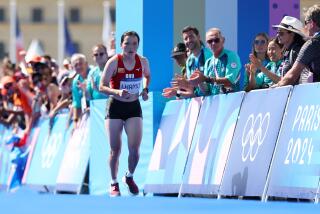The Race Is to the Swift of Thought, This Coach Says
- Share via
It sounds like a declaration in the Couch Potato Manifesto, but don’t be fooled: Yes, says David Morrow, you can think your way through an 8-kilometer race. That’s the good news.
The bad news, alas, is that you still have to move your feet and run it.
Still, says Morrow, a trainer at the Sports Club/Irvine, brain power and leg power combined can get you through the nearly five miles a lot more comfortably and efficiently than the use of pure muscle alone.
That’s what a team of seven runners, coached by Morrow, found out Sunday at the Sports Club/Irvine Bastille Day 8K Race in Newport Beach. All non-elite runners--two of them were running their first race ever--the members of Team Phoenix, as they called themselves, ran the race as a culmination of six weeks of highly focused training under Morrow’s direction. All posted times under 55 minutes.
For Team Phoenix, pounding the pavement in preparation for the race was only one of many strategies (and not even the most prominent one at that) designed to get them from point A to point B at a good running pace. The brain got as much of a workout as the body did, and the reason, Morrow said, is simple anatomy.
“The body’s not smart,” Morrow said. “The brain is smart. The brain can outfox the body.”
Or, put another way: If your brain keeps telling your body that it isn’t tired and that it doesn’t hurt, after a while it will start believing it.
To that end, Morrow put the team members through a series of exercises for the mind, including what he called a “Zen type of breathing meditation” for 20 minutes each day, and through “yoga-based stretching exercises.”
“That kind of thing exercises the mind, while the running exercises the body,” Morrow said. “It improves your mental clarity. It’s a kind of holistic view of exercise, and it’s a lot better than just going at it like a rat on a treadmill.”
Actually, there was a treadmill involved. The team took four training runs a week: two outdoors on pavement and two in the gym on treadmills, supervised by Morrow.
But even on the runs, Morrow would not let the team members leave their minds alone. When the running body began to balk at going another mile, Morrow said, the team was instructed to put a couple of mental diversions into play.
The first involved a sort of runner’s mantra. When fatigue began to set in, the runners were instructed to repeat to themselves with each step that they were “feeling better, feeling stronger,” Morrow said.
If they were inclined to slow down or stop to relieve the pain of running, they were told to strike a kind of mental deal with themselves: “ ‘I’ll go one more mile, and then after that I’ll stop,’ ” Morrow said. The idea, he said, was to keep renegotiating the deal. One more mile; another few blocks; until a landmark was reached. Eventually, the finish line would appear.
For two of the team’s members, Morrow kept an eye out for one more mental roadblock.
Team member Phil Beaudoin, president of Electro-Numerics of Irvine and an avid runner, had undergone cardiac double-bypass surgery. Linda O’Toole, the general manager of Le Meridien hotel in Newport Beach had undergone two operations on her back, one of which involved fusing vertebrae. Neither experienced any surgery-related pain during training, but, Morrow said, there could have been the nagging thought “that they might hurt.”
It never materialized, he said. Beaudoin ran the course in slightly under 43 minutes, and O’Toole, running her first race ever, finished in 53.5 minutes.
Other team members were enthusiastic about Morrow’s multidisciplinary approach.
“I’d quit running for about six months,” said Kevin Jones, manager of the Saturn of Santa Ana auto dealership. “I feel a lot better now than I did at the beginning of training. There were things I didn’t expect. We did a lot of treadmill and a lot of meditating and stress management, which I didn’t think we’d be doing. I couldn’t have run this race six weeks ago.”
Richard Reisman, publisher of the Orange County Business Journal, said that overall fitness readings were taken for each team member at the beginning and at the end of training, “and for me, every dimension of fitness improved. I even lost 10 pounds. We all lost weight.”
He also finished in just over 40 minutes. It was his first race.
But it was O’Toole who perhaps had the most heartening experience. Because she was expected to finish with the longest time, the rest of the Team Phoenix members had planned to finish, then backtrack to about the four-mile mark, pick her up and run the final mile with her. But at the time they expected her to reach the four-mile mark, she had passed it by almost half a mile, nearly six minutes faster than expected. The team settled for running the last half mile with her.
Did she want to do it again? In answer, she pulled out of the pocket of her running shorts an entry form for an upcoming race.


